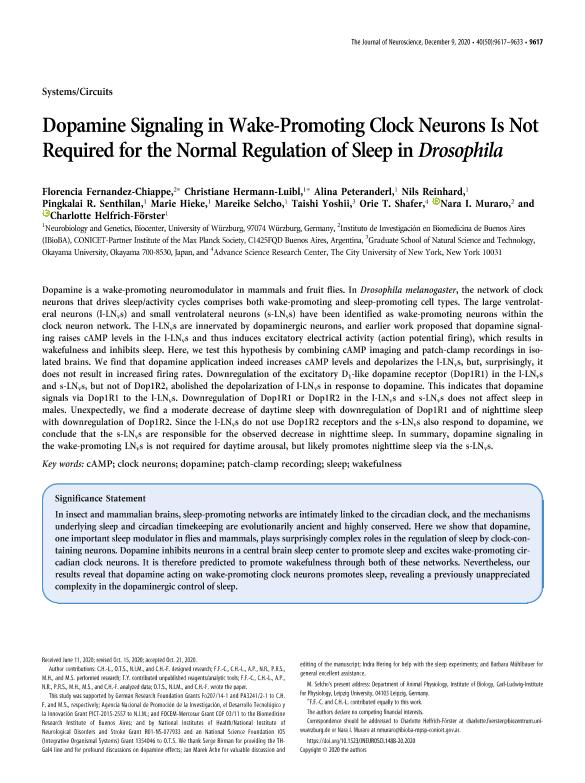Mostrar el registro sencillo del ítem
dc.contributor.author
Fernández, Florencia

dc.contributor.author
Hermann Luibl, Christiane
dc.contributor.author
Peteranderl, Alina
dc.contributor.author
Reinhard, Nils
dc.contributor.author
Senthilan, Pingkalai R.
dc.contributor.author
Hieke, Marie
dc.contributor.author
Selcho, Mareike
dc.contributor.author
Yoshii, Taishi
dc.contributor.author
Shafer, Orie T.
dc.contributor.author
Muraro, Nara Ines

dc.contributor.author
Helfrich Förster, Charlotte
dc.date.available
2021-10-12T14:47:10Z
dc.date.issued
2020-12-09
dc.identifier.citation
Fernández, Florencia; Hermann Luibl, Christiane; Peteranderl, Alina; Reinhard, Nils; Senthilan, Pingkalai R.; et al.; Dopamine signaling in wake-promoting clock neurons is not required for the normal regulation of sleep in drosophila; Society for Neuroscience; Journal of Neuroscience; 40; 50; 09-12-2020; 9617-9633
dc.identifier.issn
0270-6474
dc.identifier.uri
http://hdl.handle.net/11336/143278
dc.description.abstract
Dopamine is a wake-promoting neuromodulator in mammals and fruit flies. In Drosophila melanogaster, the network of clock neurons that drives sleep/activity cycles comprises both wake-promoting and sleep-promoting cell types. The large ventrolateral neurons (l-LNvs) and small ventrolateral neurons (s-LNvs) have been identified as wake-promoting neurons within the clock neuron network. The l-LNvs are innervated by dopaminergic neurons, and earlier work proposed that dopamine signaling raises cAMP levels in the l-LNvs and thus induces excitatory electrical activity (action potential firing), which results in wakefulness and inhibits sleep. Here, we test this hypothesis by combining cAMP imaging and patch-clamp recordings in isolated brains. We find that dopamine application indeed increases cAMP levels and depolarizes the l-LNvs, but, surprisingly, it does not result in increased firing rates. Downregulation of the excitatory D1-like dopamine receptor (Dop1R1) in the l-LNvs and s-LNvs, but not of Dop1R2, abolished the depolarization of l-LNvs in response to dopamine. This indicates that dopamine signals via Dop1R1 to the l-LNvs. Downregulation of Dop1R1 or Dop1R2 in the l-LNvs and s-LNvs does not affect sleep in males. Unexpectedly, we find a moderate decrease of daytime sleep with downregulation of Dop1R1 and of nighttime sleep with downregulation of Dop1R2. Since the l-LNvs do not use Dop1R2 receptors and the s-LNvs also respond to dopamine, we conclude that the s-LNvs are responsible for the observed decrease in nighttime sleep. In summary, dopamine signaling in the wake-promoting LNvs is not required for daytime arousal, but likely promotes nighttime sleep via the s-LNvs.
dc.format
application/pdf
dc.language.iso
eng
dc.publisher
Society for Neuroscience

dc.rights
info:eu-repo/semantics/openAccess
dc.rights.uri
https://creativecommons.org/licenses/by-nc-sa/2.5/ar/
dc.subject
CAMP
dc.subject
CLOCK NEURONS
dc.subject
DOPAMINE
dc.subject
PATCH-CLAMP RECORDING
dc.subject
SLEEP
dc.subject
WAKEFULNESS
dc.subject.classification
Biología

dc.subject.classification
Ciencias Biológicas

dc.subject.classification
CIENCIAS NATURALES Y EXACTAS

dc.title
Dopamine signaling in wake-promoting clock neurons is not required for the normal regulation of sleep in drosophila
dc.type
info:eu-repo/semantics/article
dc.type
info:ar-repo/semantics/artículo
dc.type
info:eu-repo/semantics/publishedVersion
dc.date.updated
2021-04-28T21:27:57Z
dc.journal.volume
40
dc.journal.number
50
dc.journal.pagination
9617-9633
dc.journal.pais
Estados Unidos

dc.journal.ciudad
Washington
dc.description.fil
Fil: Fernández, Florencia. Consejo Nacional de Investigaciones Científicas y Técnicas. Oficina de Coordinación Administrativa Parque Centenario. Instituto de Investigación en Biomedicina de Buenos Aires - Instituto Partner de la Sociedad Max Planck; Argentina
dc.description.fil
Fil: Hermann Luibl, Christiane. University Of Würzburg; Alemania
dc.description.fil
Fil: Peteranderl, Alina. University Of Wuerzburg; Alemania
dc.description.fil
Fil: Reinhard, Nils. University Of Wuerzburg; Alemania
dc.description.fil
Fil: Senthilan, Pingkalai R.. University Of Wuerzburg; Alemania
dc.description.fil
Fil: Hieke, Marie. University Of Wuerzburg; Alemania
dc.description.fil
Fil: Selcho, Mareike. University Of Wuerzburg; Alemania
dc.description.fil
Fil: Yoshii, Taishi. Okayama University; Japón
dc.description.fil
Fil: Shafer, Orie T.. City University of New York; Estados Unidos
dc.description.fil
Fil: Muraro, Nara Ines. Consejo Nacional de Investigaciones Científicas y Técnicas. Oficina de Coordinación Administrativa Parque Centenario. Instituto de Investigación en Biomedicina de Buenos Aires - Instituto Partner de la Sociedad Max Planck; Argentina
dc.description.fil
Fil: Helfrich Förster, Charlotte. University Of Wuerzburg; Alemania
dc.journal.title
Journal of Neuroscience

dc.relation.alternativeid
info:eu-repo/semantics/altIdentifier/url/https://www.jneurosci.org/content/40/50/9617
dc.relation.alternativeid
info:eu-repo/semantics/altIdentifier/doi/http://dx.doi.org/10.1523/JNEUROSCI.1488-20.2020
Archivos asociados
